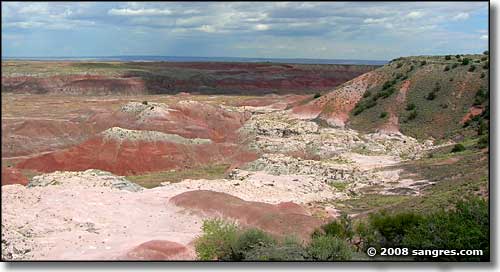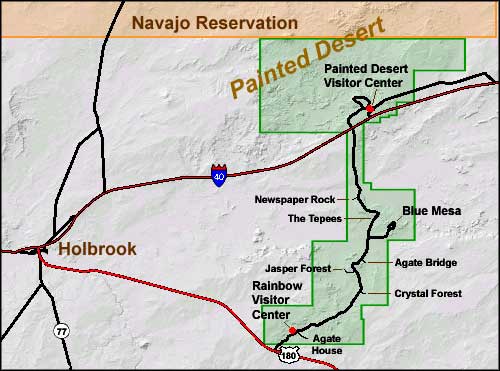
Petrified Forest National Park Wilderness

The Painted Desert
The Petrified Forest National Wilderness occupies about 52,000 acres in the Petrified Forest National Park (the Wilderness occupies more than half the Park). Most of the Wilderness Area is north of the I-40 but there is another section of designated wilderness mostly along Puerco Ridge in the southeastern section of the park.
Some 225 million years ago this was a large floodplain crossed by numerous rivers and streams. For years, the large ancestral pines that grew here fell into the rivers and became petrified over time. Buried in the sands of the river, groundwater carrying silica slowly replaced the organic materials of the wood with inorganic materials. Apparently, this wood was not buried deep enough, or quickly enough, for the temperature and pressure to build high enough to make coal out of the woody deposit before it was completely petrified. Over time, that silica crystallized into hard quartz that has the same properties and lifetime as any other very hard rock. The Chinle Formation here is some 1,800 feet thick and there are Triassic and Jurassic era fossils and petrified woods encased throughout the formation.
After millions of years of burial, exposure and re-burial, the countryside evolved into the high Arizona tableland we see today. And the same forces that sculpted and shaped the Painted Desert have also exposed the petrified forest and continue to bring more and more of that ancient material to the surface.
To go hiking here you'll want a compass and a good map: it's easy to get lost in this wild and colorful countryside. While hiking around you may come across ancient petroglyphs and stone houses that are up to 2,000 years old. There is no camping allowed in the Park but there is backcountry camping allowed in the Wilderness Area, just get a backcountry permit from the Visitor Center before they close for the day.

The Desert Inn, at the edge of the Painted Desert

